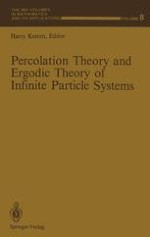1987 | OriginalPaper | Chapter
Survival of Cyclical Particle Systems
Authors : Maury Bramson, David Griffeath
Published in: Percolation Theory and Ergodic Theory of Infinite Particle Systems
Publisher: Springer New York
Included in: Professional Book Archive
Activate our intelligent search to find suitable subject content or patents.
Select sections of text to find matching patents with Artificial Intelligence. powered by
Select sections of text to find additional relevant content using AI-assisted search. powered by
We consider here a continuous time interacting particle system on Z with possible states 0,1,…,N-1 at each site. We denote by ξt(i) the state taken at site i and time t. Our models, which we call cyclical particle systems, are specified by the following transition rates: $${\xi _{\rm{t}}}{\rm{(i)}} \to {\xi _{\rm{t}}}({\rm{i}}) + {\rm{l (mod}}{\mkern 1mu} {\rm{N) at rate }}{\mkern 1mu} \lambda ,$$ where $$\lambda = \left| {\,\left\{ {\,{\rm{j}} = \pm 1:\,{\xi _{\rm{t}}}({\rm{i + j) = }}{\xi _{\rm{t}}}({\rm{i) + 1}}\,{\mkern 1mu} {\rm{(mod}}\;{\rm{N)}}} \right\}\,} \right|.$$. Note in particular that i cannot change state until at least one of its immediate neighbors has state ξt(i) + 1. For convenience, one may equip ξ with a space-time percolation substructure. Arrows from i to i+1 and i-1 are each put dow in a Poisson manner with rate 1. A state change is induced at (t, i) by an arrow at time t which enters i from i+1 or i-1, where the state is ξt(i) + 1. In diagram 1 below, numbers at the points of arrows indicate state change in the realization (N=5). Here, we will always assume that ξ0 has product measure with $${\rm{P(}}{\xi _0}{\rm{(i) = k) = 1/N}}\;{\rm{for}}\;{\rm{k = 0,}}{\mkern 1mu} 1,...,{\mkern 1mu} {\rm{N - 1}}{\rm{.}}$$
